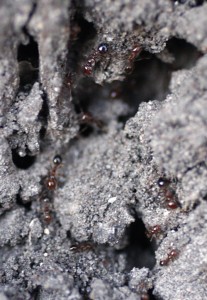
By Meghan Hendrickson
Staff Writer
Baylor engineers are researching swarm patterns of insects to provide swarm intelligence for the nation’s military.
According to Dr. Robert Marks, distinguished professor of electrical and computer engineering, there is increasing military interest in unmanned autonomous vehicles. A collection of vehicles can act like a swarm of insects, and Marks and his team are researching to find simple rules the vehicles can follow to enable the military to complete its mission.
Marks is working with Dr. Benjamin Thompson of the Applied Research Laboratory at Pennsylvania State University and his research assistant, Albert Yu, who just received his Master of Science in electrical and computing engineering from Baylor, to conduct research for the Office of Naval Research to develop swarm algorithms for Navy applications.
“Dumb bugs do smart things,” Marks said. “Bees build intricate hives. Ants build and defend anthills.”
Marks explained how ants figure out how to get the Milky Way candy bar someone drops on the sidewalk back to their home by traveling the shortest distance, despite obstacles that prevent that path from being a straight line.
“Using the same algorithm we learn from ants, we can get messages, Milky Way bars, over communication paths to their destination using information packets, ants, in a very efficient way,” Marks said.
Marks went on to say that social insects are robust and adaptive. He said that even if someone steps on half the ants taking the Milky Way bar to their home, the ants will still complete the task; it will just take longer. He said that ants are individually unaware of the overall task they are performing and they continue to follow their simple rules to complete their mission, without a master controller directing their every move. It is these simple rules that Marks and his team are trying to create for the military.
Thompson, tactical processing and control department head at the Applied Research Laboratory and Baylor alumnus, said that the ultimate goal is to create great engineers to further the mission of the Navy.
“Along the way, with this particular effort, we hope to discover new and interesting things about how swarms of autonomous vehicles can be created to interact with some predefined and useful purpose,” Thompson said.
Marks’ research stems from an idea he learned from his grandfather.
“My grandfather, who had a third-grade education, once told me that man has never done anything that God didn’t do first,” Marks said. “He is right. All of man’s engineering designs can be found in nature.”
Marks helped found the Institute of Electrical and Electronics Engineers Computational Intelligence Society, a professional society that carries the motto “Nature Inspired Problem Solving.”
Marks looks at the intelligent design found in nature to try and mimic that design in his man-made creations, a process known as biometrics.
Marks uses simulations of computer generated swarms at NeoSwarm.com in order to find patterns in swarm behaviors. He has been surprised to find interesting responses that he did not plan.
One of Marks’ computational intelligence master’s students, Daniel Jepson, uses the simulations for the class research.
“My research revolves around a small band of fierce Spartans fighting their way out of an overwhelming army of drunken Persians,” Jepson said. “The research uses swarm inversion and outfits each Spartan with a few simple rules. The goal is simple: help the Spartans escape from the ambush.”
He said that after approximately 24 hours of computer simulations, interesting behaviors emerged from the swarms. Some behaviors modeled ancient Greek tactics such as the phalanx and others sent the Spartans running for their own lives, forsaking their friends.
“Computational intelligence has revealed a new world of exciting research — the kind that makes me cheer for Spartans running across my screen into the wee hours of the morning,” Jepson said.
Thompson said this project has been one of the most intellectually rewarding research projects he has been involved with.
“It seems like we come up with new and surprising insights into swarm intelligence as applied to autonomous vehicles every week, and it’s been a lot of fun along the way,” Thompson said.






